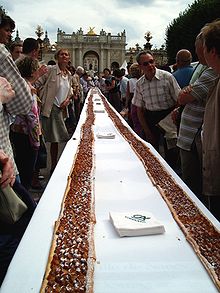- Mirabelle plum
-
- For other uses, see Mirabel (disambiguation), Mirabella (disambiguation) and Mirabello.
Mirabelle plum 
Blossom of Mirabelle plum in detail Scientific classification Kingdom: Plantae (unranked): Angiosperms (unranked): Eudicots (unranked): Rosids Order: Rosales Family: Rosaceae Genus: Prunus Subgenus: Prunus Section: Prunus Species: P. domestica Subspecies: P. domestica subsp. syriaca Trinomial name Prunus domestica subsp. syriaca The mirabelle plum, also known as the mirabelle prune (Prunus domestica subsp. syriaca), is the edible drupaceous fruit of the mirabelle prune tree, a cultivar of the plum tree of the genus Prunus. It is believed that the plum was cultivated from a wild fruit grown in Asia Minor.
Contents
Description
The mirabelle is identified by its small, oval shape, smooth-textured flesh, and especially by its dark yellow colour which becomes flecked in appearance. They are known for being sweet and full of flavour. The fruit is primarily used in jams and pies, and its juice is commonly fermented for wine or distilled into plum brandy. Ninety percent of mirabelle plums grown commercially are made into either jam (70%) or eau-de-vie (20%). The plums are also excellent when eaten fresh.
In Romania, mirabelles are usually eaten while they still are not ripe. This is when they are sour and hard, but they are still enjoyed all over the country. It is arguable whether or not the fruit is better when ripe.
The mirabelle reaches maturity and is harvested from July to mid-September (Northern Hemisphere). The traditional method of shaking the trees is now mechanized, but the principle remains the same: The ripe fruits are shaken loose and collected in a net under the tree.
Mirabelle de Lorraine
The mirabelle is a specialty of the French region of Lorraine, which has an ideal climate and soil composition for the cultivation of this fruit. This region produces 15,000 tons of mirabelle prunes annually, which constitutes 80% of global commercial production.
There are two main cultivars grown for fruit production, derived from cherry plums grown in Nancy and Metz. The Metz type is smaller, less hard, and less sweet, and has no small red spots on the skin. It is very good for jam, while the Nancy type is better as fresh fruit as it is sweeter.
Since 1996 the mirabelle de Lorraine has been recognized and promoted by the EU as a high-quality regional product, with a Protected Geographical Indication (PGI). This label guarantees a minimum fruit size (22mm) and sugar content, and can only be used in a specific geographical zone of production.
References
- European Garden Flora; vol. IV; 1995.
External links
Categories:- Plum cultivars
Wikimedia Foundation. 2010.


